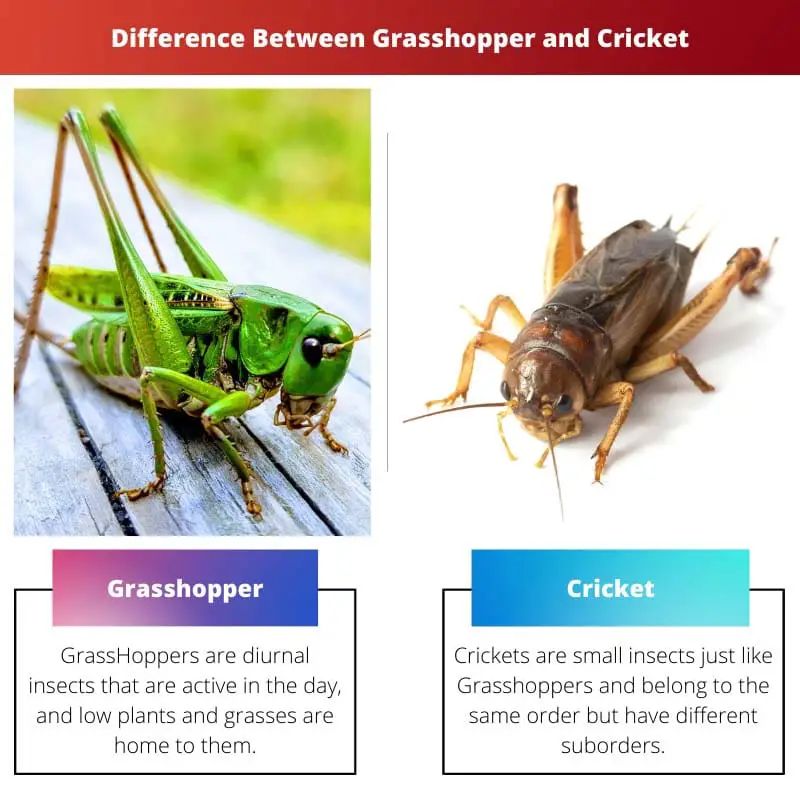There are so many insects in this world we have not even known about them. Some insects are very familiar with our habitat, and we see them in our homes or our surroundings.
Grasshopper can crickets are one of them. They are found in grasses and plants.
They both look very similar, and they both make sounds. Although they both have similar characteristics, they are very different from each other.
Key Takeaways
- Grasshoppers possess short antennae, whereas crickets have long antennae.
- Grasshoppers produce sound by rubbing their hind legs against their wings, while crickets create sound by rubbing their wings together.
- Grasshoppers are diurnal, active during the day, while crickets are nocturnal, active at night.
Grasshopper vs Cricket
Grasshoppers are larger than crickets and have longer legs, shorter antennae, and a more robust body structure. Crickets are smaller than grasshoppers, with shorter legs, longer antennae, and a more slender body structure. They are known for their distinctive chirping sound.

Grasshoppers are diurnal insects that are active during the day, and low plants and grasses are home to them. They hang out in open grassy lands.
Being largely herbivores, there are present 8000 various types of species of Grasshoppers that eat grass, plant stems, flowers, etc.
They lay their eggs in the ground and deposit them 1 to 2 inches deep in the hay or grassy lands.
Crickets are small insects just like Grasshoppers and belong to the same order but have different suborders. They are nocturnal insects are have very different behaviours.
They made chirping sounds in the night to attract females. They are smaller than grasshoppers, but they have a very long pair of antennae present.
Comparison Table
| Parameters of Comparison | Grasshopper | Cricket |
|---|---|---|
| Belonging | It belongs to suborder Caeliferans. | It belongs to the suborder Ensifera. |
| Size | They are large insects and can also grow up to 4 inches. | They are comparatively small insects and can grow up to 2 inches. |
| Antennae | They have a pair of antenna that is very short. | They have a pair of antenna that is very long. |
| Colors | They come in pale green to brown color and to hide from predators better. | They come in bright green color and many time gets camouflaged with the grasses. |
| Behavior | They are nocturnal and active at the night and can only jump. | They are active in the day and can hop, jump or fly. |
What is Grasshopper?
Belonging to Orthoptera order and suborder Caeliferans, Grasshoppers are diurnal insects and thus are up in the daylight. They are slim-bodied and have short, segmented antennae.
They are herbivores and are thus found in grasses and plants. They also produce sounds, and they do so by rubbing their wings with the hind legs.
The little ears of the grasshoppers in the base of the abdomen help them catch the sound. There are at least 8000 species of grasshopper species present.
They are larger than crickets and can grow up to 3-4 inches. Apart from the green color, they also come in a wide range of colors such as pink, blues, reds, and oranges.
They can sometimes be very harmful to the crops as they act like locusts and pests. They mostly lay eggs on the ground. They can fly, jump and hop.

What is Cricket?
Like Grasshoppers, Crickets are small insects that feed on plants and insects. They belong to the same order as Grasshoppers, but they have a different suborder, Ensifera.
They have a very long pair of antennae. Crickets can grow up to 2 inches with a round head and cylindrical body.
Producing many chirping sounds at night to attract females, Crickets are nocturnal insects that are active at night.
The more the weather is warmer, the more they produce sounds. They produce sounds mainly by rubbing the bottom of one wing with the top of another wing.
They lay their eggs in leaves or soil. They live in bushes, or plants, or grasses. They are present in almost every part of the world, and almost 900 species of crickets are present.
They feed on plants but largely feed on ants and aphids.

Main Differences Between Grasshopper and Cricket
- Grasshoppers are bigger than Crickets and are up to 4 inches in size. In contrast to that, Crickets are smaller and can be up to 2 inches.
- Grasshoppers have shorter antennae, whereas Crickets have a bigger antenna.
- Grasshopper is mostly bright green color and also can be of different colors such as red and oranges, whereas Crickets are pale green or brown in color.
- Grasshoppers are active during the day, whereas Crickets are nocturnal insects and they are active during the night.
- Grasshoppers comprise of at least 800 species, whereas 900 species of crickets are found.
- Grasshoppers feed mainly on the plant’s stem, grasses, flowers, etc., whereas Crickets feed on plants, insects, insects’ eggs, larvae, etc.
- Grasshoppers can act like pests sometimes and can destroy crops when large in numbers, whereas Crickets do not have the same behaviour, and they are not pests.
- Grasshoppers have little ears at the base of the abdomen, whereas Crickets have their little ears on the front legs.

- https://openpub.fmach.it/handle/10449/37510
- https://link.springer.com/content/pdf/10.1007/s00359-014-0946-7.pdf